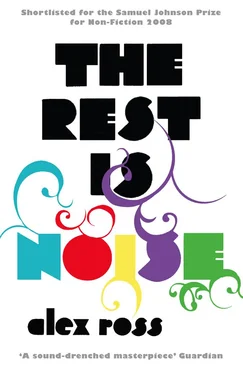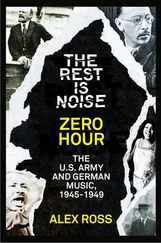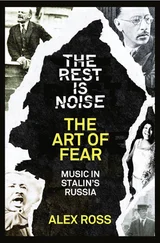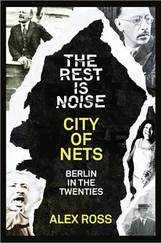Berg had an unpromising adolescence. He fathered an illegitimate child with a family servant, suffered academic failures, and, in the wake of another love affair, attempted suicide. Although he had been writing songs in Romantic and impressionist styles since the age of fifteen, his talent was hardly prodigious.
Schoenberg molded Berg into a substantial musical force, but there was a price to be paid for the transformation. For much of his youth Berg was essentially subjugated to Schoenberg’s will, sometimes functioning as little more than a valet. His tasks in the year 1911 included packing up a van when his teacher moved to Berlin, looking after bank accounts, engaging in fund-raising schemes, addressing legal problems, and proofreading and indexing Harmonielehre. After one barrage of demands, Schoenberg had the temerity to ask, “Are you composing anything?!?!” He dismissed as worthless several of Berg’s finest early works. The student never ceased his adoration, although a proud determination grew in him, together with hidden resentments.
Like Schoenberg and Webern, Berg was incubated in the golden age of Mahler and Strauss. So ardent was his Mahler worship that he once trespassed on the Master’s dressing room to steal a baton. Opulent, upward-and downward-lunging melodies of the Mahlerian variety appear in Berg’s scores from beginning to end. Strauss’s Salome made him swoon; he heard the opera in Graz, of course, and six more times in 1907, when the Breslau Opera brought its production to Vienna. “How I would like to sing to you Salome which I know so well,” Berg wrote to an American friend. His Altenberg songs, which incited the climactic outbreak of violence at the “scandal concert” of 1913, are structured around a mildly dissonant collection of five notes—C-sharp, E, G-natural, G-sharp, B-flat—which appears throughout Strauss’s opera and sounds as a single chord at the beginning of Salome’s final monologue. Luxuriating in this ambiguous sonority, the young composer seems reluctant to give up the degenerate, inbred language that Schoenberg condemned in Harmonielehre. Berg would soon be labeled the approachable Romantic of the Schoenberg school, the one who, as the conductor Michael Tilson Thomas says, makes a turn toward the audience.
Yet it wasn’t Berg’s bent for nostalgia that worried Schoenberg. Instead, he chastised his pupil for displaying a “rather too obvious desire to use new means”—perhaps thinking of the twelve-note chord in the Altenberg songs. There were always two sides to Berg; he pined for sweet, kitschy sounds, but he also had a mathematical fetish, a love of complexity for complexity’s sake.
Berg’s contrary tendencies collided in the Three Pieces for Orchestra, which were written in 1914, five years after Schoenberg’s Five Pieces and Webern’s Six. They are fully symphonic in conception, Schoenbergian in content but Mahlerian in form. The final movement is a phantasmagoric March for full orchestra, replete with thudding drumbeats and craggy brass fanfares. Notes blacken the page; instruments become an angry mob, spilling from the sidewalks into the streets. Right at the end comes a brief mirage of peace: phrases curl upward in the orchestra like wisps of cloud, and a solo violin plays a keening phrase. All the while, the harp and the celesta strike monotonous notes, which sound like the ticking of a bomb. It explodes in the last measures, with a booming trombone-and-tuba tone, a flailing, upward-spiraling movement of the brass, and a final percussive hammerblow in the bass.
The date of the completion of the March—Sunday, August 23, 1914—happens to be an infamous one in military history. The First World War had commenced at the beginning of the month; a million German troops had marched through Belgium and broached the French border. On the twenty-third, French armies began a humiliating withdrawal to the Marne, and the British Expeditionary Force fell back after the Battle of Mons. Hundreds of thousands were already dead. German soldiers were carrying out reprisals against civilians who resisted. That same Sunday night, German troops gathered the citizens of the town of Dinant and began firing into their midst, killing almost seven hundred people, including a three-week-old baby. Two days later the medieval library of Louvain was set on fire. In a few short weeks, Germany had done irreparable damage to its reputation as a cradle of modern civilization.
Wozzeck
“War!” Thomas Mann wrote in November 1914. “We felt purified, liberated, we felt an enormous hope.” Many artists were exhilarated when the Great War began; it was as if their gaudiest fantasies of violence and destruction had come to life.
Schoenberg fell into the grip of what he would later call his “war psychosis,” drawing comparisons between the German army’s assault on decadent France and his own assault on decadent bourgeois values. In a letter to Alma Mahler dated August 1914, Schoenberg waxed militant in his zeal for the German cause, denouncing in the same breath the music of Bizet, Stravinsky, and Ravel. “Now comes the reckoning!” Schoenberg thundered. “Now we will throw these mediocre kitschmongers into slavery, and teach them to venerate the German spirit and to worship the German God.” For part of the war he kept a diary of the weather, in the belief that certain cloud formations presaged German victory or defeat.
Berg, too, succumbed to the hysteria, at least at first. After finishing the March of the Three Pieces, he wrote to his teacher that it was “very shameful to be merely an onlooker at these great events.”
The massacre at Dinant, the burning of Louvain, and other atrocities of August and September 1914 were not simply mishaps of the fog of war. They fulfilled the German General Staff’s program of destroying the “total material and intellectual resources of the enemy.” The notion of total war mirrored to an uncomfortable degree the apocalyptic mind-set of recent Austro-German art.
Not everyone fell victim to “war psychosis.” Richard Strauss, for one, refused to join ninety-three other German intellectuals in signing a manifesto that denied German wrongdoing at Louvain. In public Strauss stated that as an artist he wished to avoid political entanglements, but in private he sounded a distinctly nonpatriotic tone. “It is sickening,” he wrote a few months later to Hofmannsthal, “to read in the papers of the regeneration of German art … to read how the youth of Germany is to emerge cleansed and purified from this ‘glorious’ war, when in fact one must be thankful if the poor blighters are at least cleansed of their lice and bed-bugs and cured of their infections and once more weaned from murder!” The statement reads like a riposte to Mann’s panegyric to violence. The next time Germany went to war, the two men would switch roles; Strauss would be the figurehead, Mann the dissident.
There are comical pictures of the Second Viennese School in the uniforms of the Austrian army. Schoenberg, plump and balding, looks like a village schoolmaster who has volunteered out of solemn duty. Webern, dwarfed by his helmet, is the picture of the student-soldier. Berg, leaning back in a chair with a half smile on his face and one leg crossed over the other, resembles an actor in a silent movie, perhaps a tale of a young soldier in love with an enemy maiden. None promises to pose much of a threat to the kitschmongers on the other side. Indeed, physical limitations prevented them from seeing action at the front. Schoenberg ended up playing in a military orchestra. Webern, extremely nearsighted, was attached to a reserve battalion of the Carinthian Mountain Troops. And Berg, after spending a month at a training camp in the fall of 1915, suffered a physical breakdown and had to be hospitalized. For the remainder of the fighting, he was confined to a desk job, where a beastly superior made his life miserable.
Читать дальше












